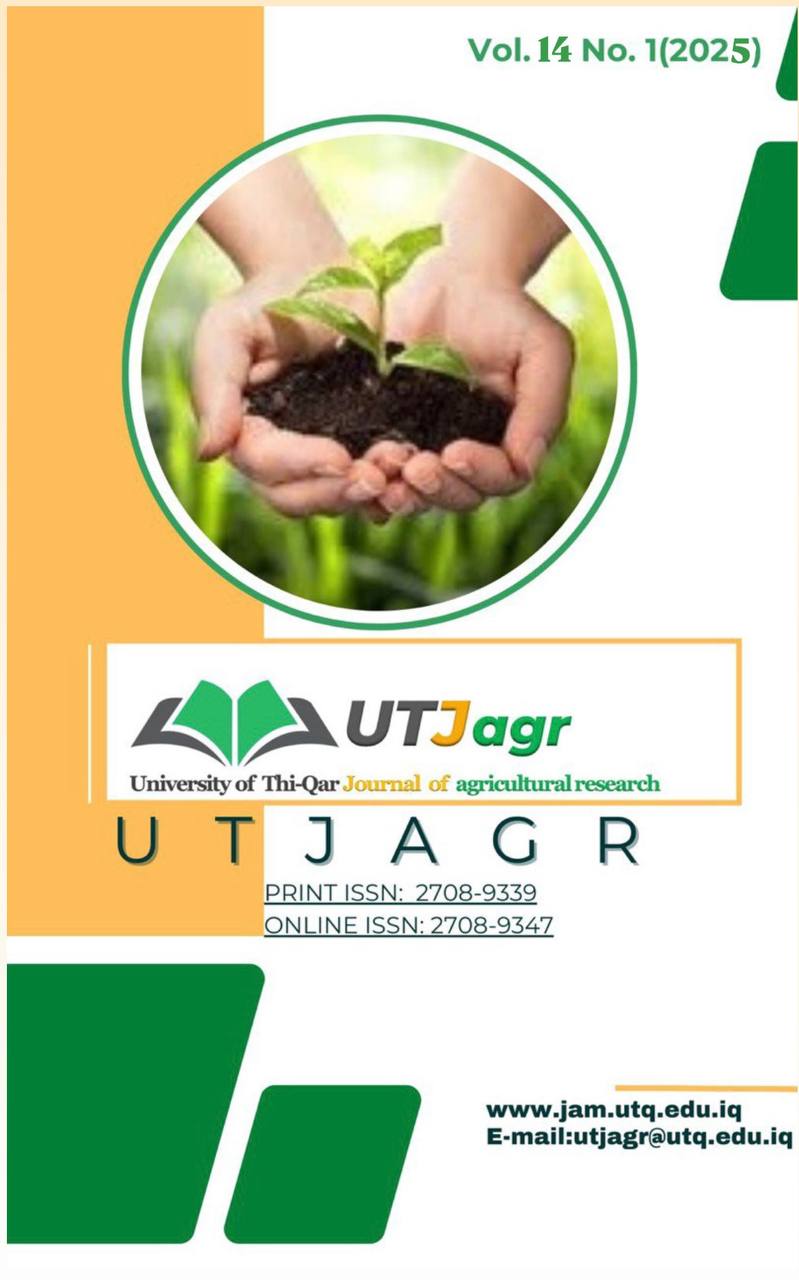Effect of replacing urea-treated sugarcane bagasse with different proportions of barley on some blood biochemical traits of Arabian sheep
DOI:
https://doi.org/10.54174/ca9st720Keywords:
Sugarcane bagasse, Arabian lambs, Urea treatment, biochemical profileAbstract
This study aimed to investigate the effect of substituting barley with urea-treated sugarcane bagasse at different ratios (0, 10, 20 and 30%) on blood biochemical parameters in the serum of Arabian lambs. The study included 16 Arabian lambs, purchased from local markets in Basra Governorate, at the age of 5-6 months, with an average weight of 25 ± 0.75 kg. Lambs were divided into four treatments (4 lambs per treatment). The treatments were: T1 the control (0% sugarcane bagasse treated with urea), T2 (10% sugarcane bagasse treated with urea), T3 (20% sugarcane bagasse treated with urea) and T4 (30% sugarcane bagasse treated with urea). The feeding period was 90 days including 14 days of adaptation. The results showed significant differences (P≤0.05) in total protein concentration (g/L) in favor of the treatments fed urea-treated sugarcane bagasse compared to the control treatment throughout the study period. There were significant differences (P≤0.05) in albumin concentration during the second month of the study in the treatments fed urea-treated sugarcane bagasse compared to the control treatment, while the differences were not significant in the first and third months of the study. There were significant differences (P≤0.05) in globulin concentration during the first and second months in favor of the treatments fed urea-treated sugarcane bagasse compared to the control treatment, while the differences were not significant in the third month. There was a significant increase (P≤0.05) in urea concentration (mmol/L) in the treatments fed urea-treated sugarcane bagasse compared to the control treatment. There was a significant increase (P≤0.05) in creatinine concentration (mmol/L) in the treatments fed urea-treated sugarcane bagasse compared to the control treatment. There was a significant increase (P≤0.05) in the concentration of liver enzymes AST and ALT (IU/L) in the treatments fed urea-treated sugarcane bagasse compared to the control treatment, but these levels remained within the normal range. It is concluded that replacing urea-treated sugarcane bagasse in lamb rations has no negative effect on the health status of lambs.
Downloads
References
Adelusi, O. O., & Ojo, V. O. A. (2018). Nutrient digestibility and blood parameters of West African dwarf sheep fed sugarcane top silage. Nigerian Journal of Animal Production, 45(2), 304-315.
Begna, R., Urge, M., Negesse, T., & Animut, G. (2019). Chemical composition and in-vitro digestibility of sugarcane bagasse and rice husk treated with three strains of white rot fungi and effective microorganism. Biotechnology in Animal Husbandry, 35(1), 71-83.
Beigh, Y. A., Ganai, A. M., & Ahmad, H. A. (2017). Prospects of complete feed system in ruminant feeding: A review. Veterinary world, 10(4), 424-437.
Broderick, G. A. (2018). Optimizing ruminant conversion of feed protein to human food protein. Animal, 12(8), 1722-1734.
Chellapandian, M., Arulnathan, N., & Thirumeignanam, D. (2024). Evaluation of Urea Treated Acacia nilotica Pods as a Feed for Grower Lambs. Asian Journal of Dairy & Food Research, 43(1).
Davis, T. C., & White, R. R. (2020). Breeding animals to feed people: The many roles of animal reproduction in ensuring global food security. Theriogenology, 150, 27-33.
da Costa, D. A., de Souza, C. L., Saliba, E. D. O. S., & Carneiro, J. D. (2015). By-products of sugar cane industry in ruminant nutrition. Int. J. Adv. Agric. Res, 3, 1-95.
Devidas, N. S. (2023). Effect of feeding urea and exogenous fibrolytic enzyme treated paddy straw on performance of growing cattle (Doctoral dissertation, Pandit Deen Dayal Upadhyaya Pashu Chikitsa Vigyan Vishwavidyalaya).
El-Hafez, A., Soliman, I. A., Mousa, S. M., & Farghly, M. M. (2003). EFFECT ON LAMBS’ GROWTH PERFORMANCE, SEMEN PHYSICAL PROPERTIES AND BLOOD SERUM CONSTITUENTS. Assiut Veterinary Medical Journal, 49(96), 73-95.
Guedes, C. M., Gonçalves, D., Rodrigues, M. A. M., & Dias-da-Silva, A. (2008). Effects of a Saccharomyces cerevisiae yeast on ruminal fermentation and fibre degradation of maize silages in cows. Animal Feed Science and Technology, 145(1-4), 27-40.
Gunun, N., Wanapat, M., Gunun, P., Cherdthong, A., Khejornsart, P., & Kang, S. (2016). Effect of treating sugarcane bagasse with urea and calcium hydroxide on feed intake, digestibility, and rumen fermentation in beef cattle. Tropical animal health and production, 48, 1123-1128.
Kobeisy, M., El-Hafez, A., Mousa, S., & Kabak, A. (2015). Physiological response to sun exposure of rams fed sugarcane bagasse silage treated with urea and live yeast culture or pronifer. Egyptian Journal of Nutrition and Feeds, 18(2 Special), 51-54.
Lamidi, A. A., & Ologbose, F. I. (2014). Dry season feeds and feeding: a threat to sustainable ruminant animal production in Nigeria. Journal of Agriculture and Social Research (JASR), 14(1), 17-30.
Singer, A. M. (2024). EFFECT OF FEEDING SORGHUM HUSK TREATED WITH DIFFERENT LEVELS OF UREA ON NUTRIENT DIGESTIBILITY, SOME BLOOD METABOLITES AND GROWTH PERFORMANCE OF GROWING SAIDI MALE LAMBS. Egyptian Journal of Nutrition and Feeds, 27(1), 11-20.
Singer, A. M., & Marwan, A. A. (2019). Effect of bagasse as a roughage source on nutrient digestibility, some blood constituents and growth performance of growing beef crossbreed calves. Egyptian Journal of Nutrition and Feeds, 22(1), 45-53.

Downloads
Published
Issue
Section
License
Copyright (c) 2025 alaa fadhil, jalal ogali usur

This work is licensed under a Creative Commons Attribution-NonCommercial-ShareAlike 4.0 International License.







1.png)

